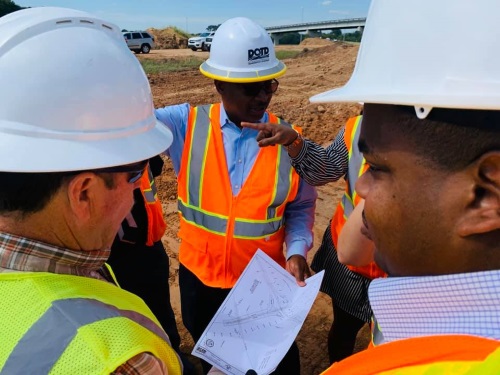A roundup of headlines curated for state transportation environmental professionals
FEDERAL ACTION
As EPA Steps Back, States Face Wave Of Requests For Environmental Leniency – NPR
With transportation’s future unclear, some question spending – Roll Call
Transportation Funding Bill Part of Congress’ Summer Agenda – Transport Topics
Federal Transit Administration Announces $22.97 Million to Improve Transit Access in Selected Communities Around the Country – Federal Transit Administration (Press release)
Wyoming jumps aboard for Trump water rule – Laramie Boomerang
Outside/In: How Massachusetts v. EPA Forced the U.S. Government to Take On Climate Change – New Hampshire Public Radio
Trump Team Weighs $1 Trillion for Infrastructure to Spur Economy – Bloomberg Tax
COVID-19
Transportation Industry Asks President to Support State DOT COVID-19 Relief – AASHTO Journal
COVID-19: President Trump’s Invocation of Emergency Authority to Streamline Environmental Review for Infrastructure Projects – National Law Review (Analysis)
Google Maps adding pandemic-critical information for commuters – Mass Transit
New poll shows Michigan voters rank fixing roads and infrastructure as top priority after COVID-19 economic recovery – Arab American News
Explore U.S. Mobility during the COVID-19 Pandemic – US Bureau of Transportation Statistics
A Playbook for Transit Recovery from D.C. – City Lab
CDOT creates fund to help cities extend restaurants onto streets – BizWest
INFRASTRUCTURE RESILIENCE AND SUSTAINABILITY
Energy and Transportation Each Have a Powerful ‘Sustainable Story’ – Bloomberg (Interview)
Florida’s Flooded Future: ‘Retreat While There’s Still Time’ – The Nation
North Carolina Climate Risk Assessment and Resilience Plan – NCDOT
Resilience Is Good Public Policy – US Chamber of Commerce (Commentary)
Board of Trustees commits to accelerating transition to net-zero greenhouse gas emissions, reports major reduction in fossil fuel investments – Stanford University
California Regulators Approve Changes to Support Microgrids as State Braces for Wildfire Season – Microgrid Knowledge
New Florida Law To Bring More Electric Charging Stations To State Highways – WUFT Radio’s Fresh Take Florida
AIR QUALITY
First-of-its-kind dust detection and warning system set for monsoon – Arizona DOT
AECOM, AT&T, Toyota, and More Partner on Dallas’ First Climate Action Plan – Dallas Innovates
New Documentary Celebrates Clean Air Act, Highlights Communities Still Waiting for Clean Air – American University
Salt Lake City, Provo closer to reaching Clean Air Act compliance for first time in decade – KSL
ENVIRONMENTAL JUSTICE
Study examines environmental justice impact of Senate Bill 181 in Colorado – University of Colorado Anschutz Medical Campus
Why ‘I can’t breathe’ is resonating with environmental justice activists – NBC News
Where can I learn more about environmental racism? – National Catholic Reporter
“Two different realities”: Why America needs environmental justice – CBS News
NATURAL RESOURCES
Will Trump’s EPA rule backfire on ‘energy dominance’? – E&E News
A Canal That Opened the Montana Prairie May Soon Dry Up – New York Times
Officials want Amtrak to preserve river access – Hudson Valley 360
HEALTH AND HUMAN ENVIRONMENT/ACTIVE TRANSPORTATION
2020 City Ratings: Top 5 U.S. Cities for Bikes – People for Bikes
‘Corona Cycleways’ Become the New Post-Confinement Commute – New York Times (subscription)
The Definitive Rules of the Road for Urban Cyclists – CityLab
WILDLIFE
Understanding Wildlife Behavioral Responses to Traffic Noise and Light to Improve Mitigation Planning – UC Davis National Center for Sustainable Transportation
TRB RESOURCES/ANNOUNCEMENTS
RFP: The Provision of Alternative Services by Transit Agencies: The Intersection of Regulation and Program – TCRP (RFP announcement)
TRB Webinar: COVID-19 Impacts on Managed Lanes – TRB
TRB Webinar: Forecasting Zero Emission Vehicles Fleet Scenarios and Emissions Implications – TRB
TRB Webinar: Human Trafficking and Mobility of Missing and Murdered Indigenous Women – TRB
Agent-based Simulation Model and Deep Learning Techniques to Evaluate and Predict Transportation Trends around COVID-19 – C2SMART Center (White paper)
MOD Webinar #6: Mobility Marketplace: Integration, Integration, Integration – USDOT
FEDERAL REGISTER NOTICES
Increasing Consistency and Transparency in Considering Benefits and Costs in the Clean Air Act Rulemaking Process – EPA (Notice of proposed rulemaking)
Environmental Impact Statement for the Western Rail Yard Infrastructure Project in New York County, New York – Federal Railroad Administration (Notice of Intent to prepare an Environmental Impact Statement)



